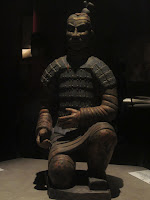The Terracotta Army Museum lies 2 km east of The Tomb of Qin Shihuang, known as the First Emperor, who unified China 2,200 years ago. Emperor Qin, from whom China gets its name, ordered the creation of this model army.
Why Were the Terracotta Warriors Made?
The army of terracotta statues was made to be buried with First Emperor Qin Shihuang:- as a show of his glory,
- to remember the army that triumphed over the other Warring States to unite China, and
- because it was believed that objects like statues can be animated in the afterlife, and because Qin Shihuang required an after-death army.
Terracotta Army Facts
The Terracotta Army was discovered in March 1974 by a farmer. The Terracotta Army was found near the tomb of Emperor Qin Shihuang, which took 38 years and 720 thousand builders to complete. The Terracotta Army was buried for 2,200 years. So far, 1,868 terracotta warriors and chariots have been unearthed. more Terracotta Army FactsAttraction name: The Qin Tomb and Terracotta Warrior and Horses
Chinese: 秦陵兵马俑 Qínlíng Bīngmǎyǒng /chin-ling bing-mah-yong/
Location: The Terracotta Army Museum is about 30 kilometers east of Xi'an in Lintong District.
Opening Hours: 8:30am–5:30pm
Ticket Price: 90 yuan (March 1–November 30); 65 yuan (December 1–February 28)
Transport from Xi'an: Bus 915, 914 or 306, or about 120 yuan by taxi.
Every figure differs from those around in facial features and expression, clothing, hairstyle, and gestures. The horsemen, the longbow bearers, the archers and the senior officers and generals were positioned in strict accordance with the ancient directives on the Art of War. Many of the figures originally held real weapons of the time, such as bronze swords, longbows, arrows, spears, dagger-axes and other long-shafted weapons. Surface treatment of the weapons made them resistant to rust and corrosion so that after being buried for over 2,000 years they were still sharp.
The Terracotta Army has lain underground for more than 2000 years. However, in 1974, farmers digging a well uncovered one of the greatest archaeological sites in the world. The first part of the Terracotta Army site to be discovered was named Vault One. In 1976, two other vaults were uncovered 20-25 meters from Vault One, and were named Vault Two and Vault Three.
Excavation of the earth and timber vaults revealed thousands of life-size terracotta warriors in battle formation - a whole army which would accompany its emperor into immortality. The discovery was a real eye-opener to the whole world, as the vaults are so big, the figures are so vivid and the number of the figures is so incredibly large!
The Terracotta Army figures supply abundant and detailed artifacts for the study of the military, cultural and economic history of that period. The Terracotta Army figures excavation was regarded as one of the greatest discoveries of the 20th century. In December 1987, UNESCO selected the Tomb of the First Emperor (including the Terracotta Army Vaults) as a World Cultural Heritage Site. Standing in the vaults, you would be amazed by such a grand ancient army formation, which would transport you back to the ancient warring states period. The tomb is a treasury for the Chinese people, and for the whole world as well.





































A book about the Terracota Warriors which explains their origins:








































































































































































































No hay comentarios.:
Publicar un comentario